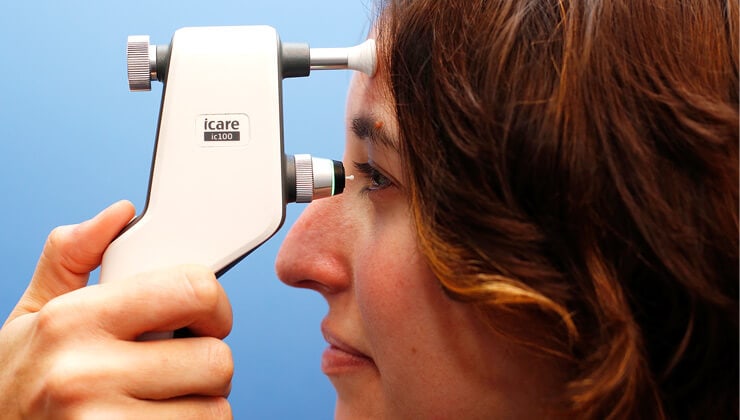
What is ocular hypertension?
Ocular hypertension occurs when the pressure inside the eye exceeds the range considered normal and goes higher than 21 mm Hg.
The increase in intraocular pressure (progressive with age, although may also be due to other disorders or causes) is the main risk factor for developing glaucoma and, therefore, people with ocular hypertension are more likely to suffer the disease. However, the two are different: ocular hypertension means that the intraocular pressure is high but the optic nerve is not damaged, whereas with glaucoma, the optic nerve has been damaged – and intraocular pressure might be normal or high – which can lead patients to notice a loss of visual field and even central vision in advanced stages of the disorder.
What causes it?
Ocular hypertension is caused by a malfunction of the drainage system for the aqueous humour, the fluid whose function is to bathe and nourish the ocular structures. When it does not flow correctly for different reasons, the balance between the fluid produced inside the eye and the fluid released from it is broken, leading to an increase in intraocular pressure (normally gradual, although it may also be sudden).
Although anyone can suffer from ocular hypertension, certain groups are more likely to suffer from it and, therefore, to develop glaucoma:
- People with a family history of ocular hypertension or glaucoma
- The over 60s
- Diabetics
- The very short- and far-sighted
- Patients with certain ocular trauma or diseases
- Black and Asian people
- Patients with a narrow ocular angle
How can it be prevented? Symptoms
Ocular hypertension cannot be prevented, but it can be closely controlled with regular check-ups (especially in the case of risk factors) and reduced by different treatments to avoid damage to the optic nerve and an irreversible loss of vision as a result of glaucoma.
Symptoms
The increase in intraocular pressure goes unnoticed in patients and no symptom is manifested (except for the sudden onset of acute glaucoma, which causes intense pain). Therefore, the only way of detecting ocular hypertension is through a comprehensive eye examination in which the value of the intraocular pressure is measured using a test known as tonometry.
When ocular hypertension causes glaucoma (i.e. it damages the optic nerve), this also generally goes unnoticed if an examination is not performed, as the decrease in vision is often peripheral at the start of the disease and does not become obvious until it is in very advanced stages.
Associated treatments
The treatment of ocular hypertension, individualised according to each case, can be through drugs (different types and combinations of eye drops), laser (trabeculoplasty) or various surgical techniques that seek to achieve an effective reduction of intraocular pressure with the least impact for the patient.
Specialists who treat this pathology
FAQs
An increase in eye pressure is a result of several factors which can be summarised as mechanisms that prevent intraocular fluid (aqueous humour) from being removed properly through the normal channel. This can be mild and chronic—chronic glaucoma—or sudden, due to other processes. The ophthalmologist has to examine the patient urgently, especially in the event of acute forms.
IMO Institute of Ocular Microsurgery
Josep María Lladó, 3
08035 Barcelona
Phone: (+34) 934 000 700
E-mail: international@imo.es
See map on Google Maps
By car
GPS navigator coordinates:
41º 24’ 38” N – 02º 07’ 29” E
Exit 7 of the Ronda de Dalt (mountain side). The clinic has a car park with more than 200 parking spaces.
By bus
Autobus H2: Rotonda de Bellesguard, parada 1540
Autobus 196: Josep Maria Lladó-Bellesguard, parada 3191
Autobuses H2, 123, 196: Ronda de Dalt – Bellesguard, parada 0071
How to arrive at IMO from:
IMO Madrid
C/ Valle de Pinares Llanos, 3
28035 Madrid
Phone: (+34) 910 783 783
See map in Google Maps
Public transport
Metro Lacoma (líne 7)
Autobuses:
- Lines 49 & 64, stop “Senda del Infante”
- Line N21, stop “Metro Lacoma”
Timetables
Patient care:
Monday to Friday, 8 a.m. to 9 p.m.
IMO Andorra
Av. de les Nacions Unides, 17
AD700 Escaldes-Engordany, Andorra
Phone: (+376) 688 55 44
See map in Google Maps
IMO Manresa
C/ Carrasco i Formiguera, 33 (Baixos)
08242 – Manresa
Tel: (+34) 938 749 160
See map in Google Maps
Public transport
FGC. Line R5 & R50 direction Manresa. Station/Stop: Baixador de Manresa
Timetables
Monday to Friday, 09:00 A.M – 07:00 PM








